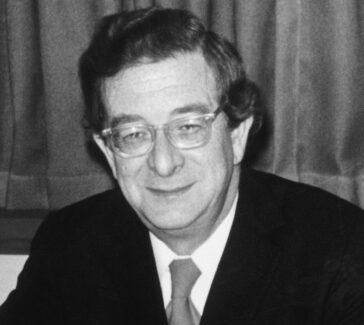George Rosenkranz
An organic chemist and a pioneering steroid researcher, Rosenkranz was instrumental in developing one of the most world-changing pharmaceuticals in history: the oral contraceptive.

Following a harrowing escape from Europe before the outbreak of World War II, George Rosenkranz went on to become CEO and chairman of Syntex, a hugely successful pharmaceutical company.
Born in Budapest, Rosenkranz (1916–2019) was the only child of successful middle-class parents of Jewish descent. His childhood was filled with an appreciation for art, music, theater, and education, and although he demonstrated a gift for modern languages, his scientific studies, particularly chemistry, held a stronger appeal.
In 1933 he left home to attend college at the Swiss Federal Institute of Technology in Zurich, where he took an organic chemistry course taught by the future Nobel laureate Lavoslav (Leopold) Ružička. Rosenkranz was inspired by Ružička, who was working to synthesize the male sex hormone testosterone, and asked to continue studying under him. In 1937 he became Ružička’s doctoral student, receiving his degree in 1940.
Around this time, the Axis countries rose to power. Ružička protected Rosenkranz and his other Jewish colleagues from Nazi sympathizers in Zurich, but they decided to leave the continent, not wanting to put their mentor at risk. Through connections Rosenkranz secured a professorship in Ecuador. The plan was to travel to Cuba, via Spain, and then on to Ecuador. He made it as far as Havana, but then the attack on Pearl Harbor sent the world into chaos, and his transport to Ecuador never materialized. Stranded in Cuba, Rosenkranz made the best of the situation and began looking for work. He was hired by Vieta-Plasencia Laboratorios, where he developed successful treatments for venereal disease.
LEARN MORE
Biography is one way of learning about a person. Oral history is another. Spend a few minutes listening to George Rosenkranz’s interview archived by the Science History Institute’s Center for Oral History. What do you hear? Has the recording picked up background noises, interesting accents, nervous laughter, or meaningful pauses? What might these tell you about the interview context, who is speaking, or how the speakers feel about the memories being discussed? What do think you can learn about Rosenkranz from his oral history that is different from the content of this biography?
The Syntex Years
In 1945 Rosenkranz received an invitation to interview with a company called Syntex in Mexico City. Syntex was a synthetic-hormone research firm founded just a year earlier by chemist Russell Marker and two others. They were attempting to make synthetic hormones from diosgenin, a naturally occurring plant hormone found in wild Mexican yams.
Rosenkranz impressed his interviewers, and they offered him the position of head chemist on the spot. After a brief return to Havana he moved to Mexico to work for Syntex, where he spent his entire career, much of it as CEO and board chairman until his retirement in 1981.
With an unlimited research budget Rosenkranz was able to hire the best and brightest organic chemists, including Carl Djerassi and Alejandro Zaffaroni. Their collaboration was fruitful. Over the years Rosenkranz and his many colleagues created and curated revolutionary advances in the understanding of and production techniques for steroid drugs, using native Mexican plant sources as raw materials.
In 1951 Syntex synthesized the first effective oral contraceptive substance (norethindrone). Under his direction the firm went on to become the leading supplier of the oral contraceptive pill (“the pill”) and other corticoids, permanently changing social structures and medical advancements all over the world. The company’s research center eventually relocated to Palo Alto, California.
Continuing Influence and Recognition
Rosenkranz’s name is on more than 150 patents, and he published more than 300 research articles on steroid hormones. After he retired he maintained many roles within the industry, including membership in the New York Academy of Sciences and positions on the board of governors of the University of Tel Aviv, the Weizmann Institute of Science, Digital Gene Technologies, and ICT Mexicana. The National Academy of Medicine of Mexico made Rosenkranz an honorary member in recognition of his dedication to scientific work and to training Mexican colleagues at Syntex.
In 2004 Rosenkranz jointly received, with Alejandro Zaffaroni, the Chemists’ Club’s Winthrop-Sears Medal; and in 2013 the Biotechnology Innovation Organization and the Chemical Heritage Foundation, now the Science History Institute, honored him with the Biotechnology Heritage Award, recognizing this “steroid chemist extrordinaire” as a pioneering entrepreneur in bio-pharma and as the orchestrator of Syntex and “the pill.”
Rosenkranz was also a world-class bridge player who authored 15 books on contract bridge and won 12 North American Bridge Championships.



